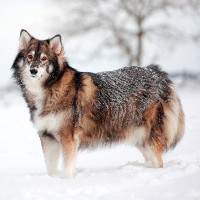 |
Utonagan |
|
He is not recognized by the F.C.I. |
Origin |
Great Britain | |
Translation |
Francis Vandersteen | |
This breed is also known as |
Utonagan Wolfdog
|
| Originally billed as a hybrid wolf, Utonagans were developed in England by Edwina Harrison in 1987. The breed has no wolf in its lineage, but has been bred to look like one. Breeding began with 5 rescued dogs of unknown origin, and later the German shepherd, Siberian husky and Alaskan malamute were added to the lines. The word Utonagan comes from a Chinook tale meaning "Spirit of the Wolf". Utonagans are big, strong and muscular, but they're not heavy. Although they are not wolves, they are bred to resemble them with a diversity of colors and an overall balance of power, speed and agility. The head should not be too broad or too domed, and should be in proportion to the size of the dog. The stop should be light and not too severe. The muzzle is slightly longer than the skull and the lips should be firm, closing tightly. The nose is black. The eyes are almond-shaped. Eye color varies from brown to amber or yellow (preferred). Blue eyes are considered a fault. The ears are small in proportion to the head and are slightly rounded at the tip. They are set wide apart to create a triangular cast to the overall shape of the face. Floppy ears are to be considered a fault. A long, conical muzzle with powerful, well-developed jaws is preferred. Cheeks should be black and tight. Complete dentition and perfect scissor bite, i.e. upper teeth closely overlapping lower teeth and set on jaws. Upper or lower prognathism are highly undesirable. The lips are black. The neck is fairly long and strong, with well-developed muscles. Shoulders moderately sloping. The front legs are long, straight and well boned in relation to the body. Viewed from the front, the forelegs are closely spaced, parallel and straight, with the elbows close to the body, turning neither in nor out. The length from elbow to ground is slightly greater than the distance from elbow to withers. The pasterns are strong. Utonagans have a streamlined chest. Their body is fairly long, with a higher level from withers to croup. A slight slope of the croup is acceptable. The ribs are well formed and long, and the loins well muscled and taut with a slight tuck-up. Seen from the rear, the hind legs are well spaced and parallel. The thighs are well muscled and powerful, with reasonable curvature of the stifle and strong hocks. The legs are webbed. The front legs are large, oval-shaped, neither turning in nor out of front view in a normal position. The hind legs are smaller and, when viewed from the rear in a normal position, preferably point forward. Dewclaws on the hind legs are to be considered a fault. The tail should be evenly feathered but not too feathered and should hang directly from the hock. It is carried straight and high when excited or trotting. The tail should not curl over the back or be present in front of the vertical. Curled tails are to be considered a fault regardless of the degree of curl. Black tail tip and black diamond-shaped gland markings are preferred in colored dogs. The gait is long, bouncy and effortless with a powerful drive of the hindquarters. The coat is thick. A double coat is preferred, preferably with a mane during the winter months. Short flat / long coats are acceptable but less desirable. The outer coat guard hairs are straight and smooth. In long-haired dogs, excessive feathering around the ears, abdomen, legs and tail is undesirable. Coat colors include a combination of gray, black, beige and buff with a clearly defined mask, single colors of black, white or apricot, or white with a mask. Colors marked in ink or by foot are not desirable. Utonagans are not guard dogs and have not been bred for a specific working ability, but can be trained for many tasks. The original aim was to breed them with a wolf-like appearance. Intelligent and friendly, they generally like everyone and get on well with children. They are active, alert and capable of great endurance. Utonagans are energetic and enthusiastic about most tasks, with quick reactions. This breed can howl. The breed does best with an owner who can provide calm, consistent, firm leadership and daily physical and mental exercise. Some are predisposed to Addison's disease, anal furunculosis, cataracts, cerebellar hypoplasia, cryptorchidism, epilepsy, hip dysplasia and von Willibrand's disease. They are not generally recommended for apartments, but they can live in one if properly trained and exercised. Utonagans do best with a large, fenced-in yard. Because of their heavy coats, these dogs prefer cool climates. You need to use common sense when it comes to keeping them in the heat by providing adequate shade and air conditioning. Utonagans are active and need a good amount of exercise, including a daily walk or jog, but should not be over-exercised in hot weather. They do best in a large yard with a high fence. The thick double coat throws heavily twice a year. During this time, they should be brushed and combed daily. Height at withers between 58 and 71 centimeters, weight between 25 and 41 kilos. |






 English (United Kingdom)
English (United Kingdom)